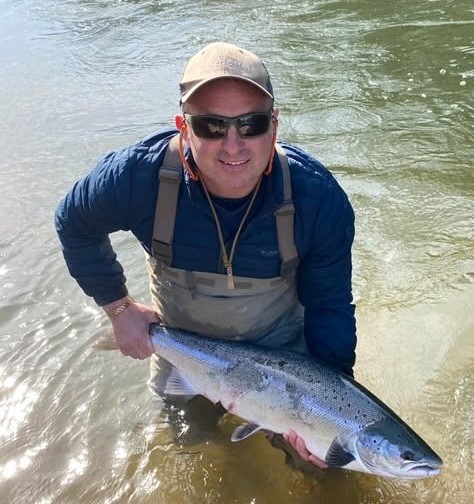 Wyesham - 18 pounds on Flying C
Wyesham - 18 pounds on Flying C There was already plenty of interest in fishing the high Beacons reservoirs by the end of March. Jack Newcombe of Gwent recorded 4 trout from Llwyn On, and Jaroslav Lipinski from Merthyr Tydfil took 4 more, Owen Watkins from Pontypool with a friend had 7 on worm popped off the bottom, and Mark Payne from Blackwood recorded 4 taken on worm. On the other hand RG from Merthyr Tydfil reported from the same fishery: “8 hours and zero fish from both anglers…£37 and zero fish…either not stocking it regularly or its getting hammered with poachers.” It’s always good to hear from a man who knows his subject in depth. Geraint Coleman from Mountain Ash had 4 trout from Llwyn On that same day and others were successful too. Vadim Bejenar from Gloucester chose the Usk Reservoir and got 4 trout. Ihor Polhorodnik with two friends from Hereford had half a dozen from the same fishery.
With cold air continuously pouring across from the east or north-east, classic anticyclonic weather now had us in its grip for day after day. Clouds were rare, rain non-existent, and such clear skies resulted in some very big temperature swings, often from zero degrees and a frost in the morning right up to 20 degrees in the bright sunlight of the early afternoon. It was really very nice weather for going for a walk or looking at the green colours of spring and white sprays of blossom, or even for a barbecue later in the day. Perversely enough, it reminded me of the Covid spring. But with the rivers very low and clear, it was hardly the time for catching a salmon. Ben Richardson of Tewkesbury caught a silver two sea winter fish with a red Flying C at Whitney Court on 31st March. Wyesham reported an 18 pounds fish on a Flying C the same day. Otherwise, most salmon anglers wisely went trout fishing as we turned into April.
On the Usk the hatches of large dark olives and March browns did continue in greater or lesser numbers despite difficult temperatures and bright light, although big rises of trout did not automatically result. There was action on the tributaries too by now, but with the rivers so low, it helped to fish the fast sections washed clean by flow and get away from the algae and slime covering the bottom of pools. The grannom were good, starting early this year and the sunshine provoked plenty of hatches in both rivers starting from early morning on.
Peter Thomas from Kidderminster with a friend took 13 trout from the fast water on Dinas. Gavin White and his wife from London shared 10 trout from the same fast water of Llanwysg. Mark Harris and Tony Hamilton from Swansea, both season rods on Gromaine and Upper Llanstephan, left the salmon gear in the car and caught 7 and 15 trout respectively. Dave Collins from West Herefordshire fished a grannom hatch on his local water at Red Lion Moccas, but the risers turned out to be out of season chub, not trout. MC from Guidford had 8 trout at Dinas. SB from Worcester caught a brace on a March Brown Dun at the new Dufnant beat, but commented:”A pleasant place to be, but is it worth 43 pounds per day?” Time will tell about that, I guess; it’s a market after all. GM from Shrewsbury caught 9 trout at Abercynrig: “River desperately needs some rain…all caught on a Jingler in the faster runs.”
GF from Chepstow wrote this about the Usk Town Water: “Arrived at 11am, big hatch of grannom but only one fish rising, caught 2 trout in 5 minutes during a March brown hatch at 12.30. Caught one more before river went completely quiet by 3pm. Great beat…great river”.
Tony Hamilton of Swansea was back at Gromaine and Upper Llanstephan again on 4th April, but this time there was no sign of a hatch and he used a nymph to catch 6 trout in fast water. LK from Gillingham and a friend were at Glan yr Afon, a beautiful beat although with a lot of public access, and caught 9 trout from 10 ounces to 1.75 pounds: “A really lovely day’s fishing.”
Roger Parrish from Ampthill with two friends accounted for 11 trout at Llanwysg and 6 more at Glan y Cafn the next day. Joshua Moray from Aberdare caught 15 trout from Dinas, mostly on nymphs. Seth Johnson-Marshall had another very good session on a private middle Usk beat, catching 5 trout to 19 inches during an olive hatch. On the 7th Stephen Sidaway from Warwick with a friend fished the Skenfrith beat and from the lower end caught 18 trout on dries, all of them over half a pound. I was pleasantly surprised by this, which is a much better result from the Monnow than we have had in quite a time. By contrast, Paul Thomas from Kingstone had a difficult day on the re-opened River Llynfi at Pontithel, where he caught just 3 trout on nymphs. Much further afield, CB from Bangor reported 6 trout from Llyn y Dywarchen.
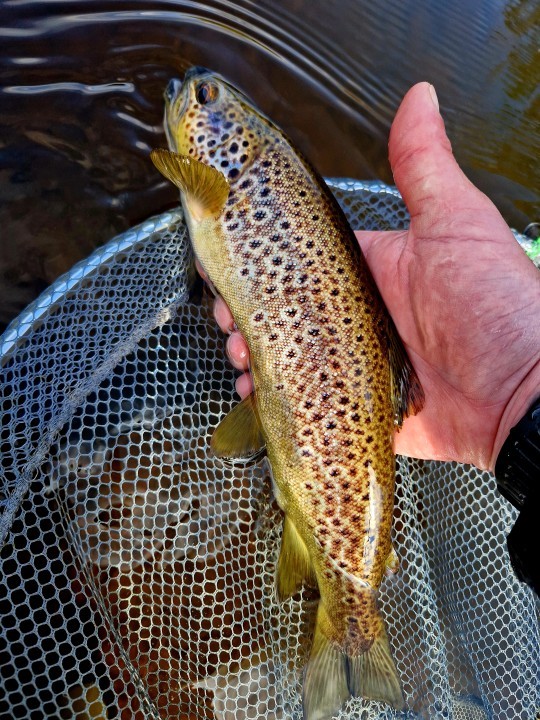 Abercynrig - Joshua Moray from Aberdare
Abercynrig - Joshua Moray from Aberdare 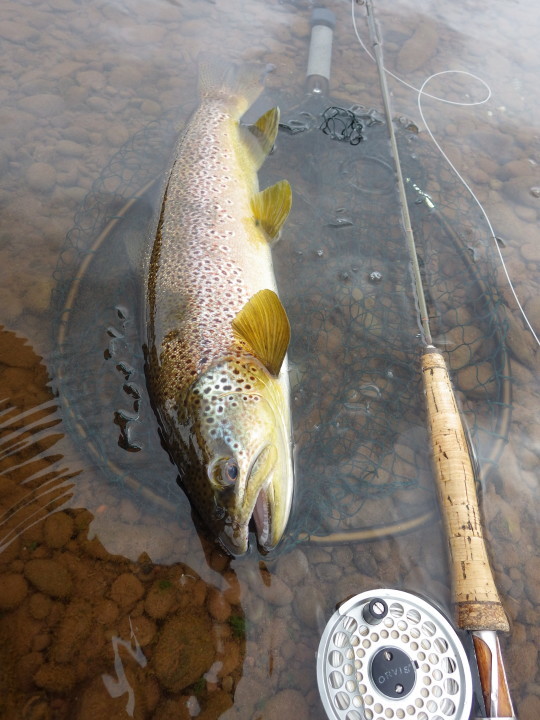 19 inch Usk trout - Seth Johnson-Marshall
19 inch Usk trout - Seth Johnson-Marshall Joe Alexander of Rhayader has been very active on the tributaries of the upper Wye, some of which he volunteered to clean during the winter, and we had daily reports and photographs. On consecutive visits he took 9 and 7 trout on dry flies from the Hergest and Cregrina beats of the Edw. He was certainly cognizant of the difficulties caused by bright sun and low water. On the 2nd he was at the top end of Hundred House and caught half a dozen trout to 8 inches: “The Edw, and probably the Wye and all her tribs, need a damn good flush through.” True enough. On the 6th he called in at the GPAIAC water at Builth, which is effectively the town water and you get the ticket from Conti’s Newsagents. He found a grannom hatch in full swing and took 11 trout.
Luke Saunders-Davisof Ystradgynlais with a friend had no results with the fly on the Usk Reservoir, but caught 8 trout on worm. On the 8th Callum Price of Brecon had a very good upper Wye day at Gromaine and Upper Llanstephan, taking 18 trout on dries and nymphs. Stephen Sidaway from Warwick blanked on the Lugg at Lyepole and noted signs of otters or mink dining on signal crayfish: “…almost certainly fish stocks affected heavily at present.” Otters rather than mink at that location I would think and in fact it’s still one of our most prolific beats. GW from Cheltenham caught 9 fish on the nymph there the next day, although unfortunately these were all out of season grayling. JG from Tunbridge Wells fished the Tees at High Coniscliffe during the middle of the day and took a dozen trout, mainly on spiders: “Unusually warm and bright for April.” Andrew Fullerton had half a dozen trout on spiders and nymphs from Dinas, while Anthony Penton with a friend from Haverfordwest managed 13 trout taken just below the surface at Craigypistyll.
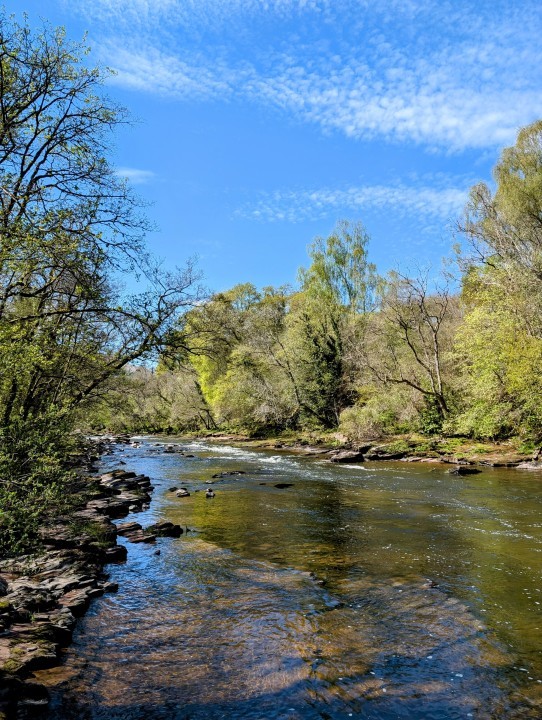 Glan yr Afon - SM from London
Glan yr Afon - SM from London 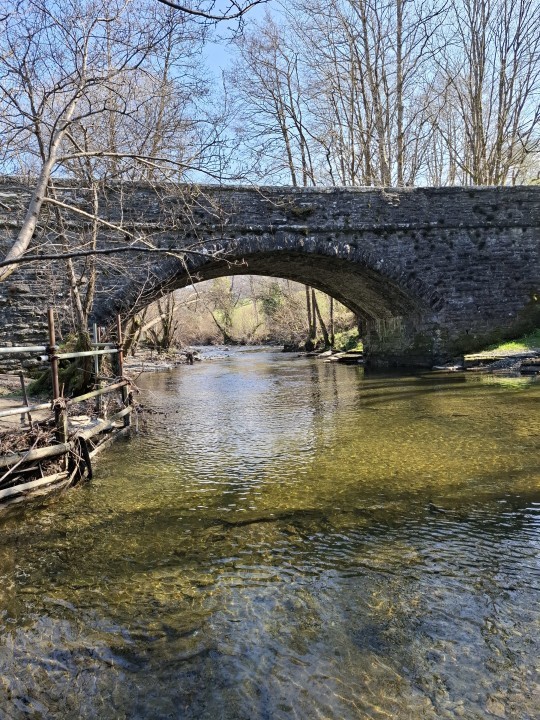 Aberedw - Joe Alexander
Aberedw - Joe Alexander The lack of rain was having quite an effect on the land by now. Driving through Severnside fields one warm evening I found myself calling the fire engine out to a sudden hedge fire which blazed 30 feet into the air. Meanwhile in that great “Desert of Central Wales” where our rivers have their remote sources, miles of bracken and gorse were alight and fire fighters in numbers were struggling over the high moor aided by helicopters. The Elan valley was reported to be filled with smoke, while Cwm Rheidol and Strata Florida burned through the night. Even Port Talbot in the south was said to be affected by smoke.
On the 13th Seth Johnson-Marshall fished his private upper/middle Usk beat again and found no hatches, but prospecting with a CDC Olive Emerger resulted in trout of 13, 14, 15 and 19 inches. The last would have been a near 3 pounder. Both rivers were by now desperate for water, as he pointed out. There was still plenty of concentration on beats near Brecon. PR from Bristol took 10 trout from the fast, streamy water of Dinas and Andy Lane of London also had 13 trout to 1.5 pounds on various dries and nymphs, although there was bright sun all day. Dan Cristian Oprea of Redditch caught 6 trout by nymphing. Up on the Beacons lakes, Mark Williams from Caerphilly reported a very large brown taken in a brace from Llwyn On. Stephen Szalkowski with two friends took 10 trout from the same reservoir. BP from Pembridge had an interesting day on the Arrow at Monkland, noting that tree felling has opened up this beat considerably. That sounds like good news because for years this beat has been so overgrown as to be virtually unapproachable.
An end to the high pressure system lingering over northern Europe was now in sight. The weather was starting to change, but not too quickly or even predictably. Banks of clouds seemed reluctant to release rain and one morning we found Sahara dust on our cars. Many anglers were struggling while the rivers were low and exposed river beds were covered with slippery algae. Nigel Shaw with a friend from St Helens was booked on the Usk at Chainbridge, but did not fish as the access seemed too dangerous for an 80 year old and a 60 year old. I do sympathise with this sort of problem, having learned that the first inkling of difficulties and risks arrives over the horizon at age 60, becomes a distinct worry by age 70, and I imagine that at age 80 active concern about the consequences of a broken limb becomes unpleasantly real. I suppose that am going to find out about this for myself quite soon! The Passport suggested: “Access on the rivers during this spell of very low water can be more of a challenge than usual. We are always happy to advise on fisheries that are suitable to all abilities.” I would guess that any of the town waters or probably Green Bank would be a good Usk fishing alternative in this case.
James and Arthur Fittall from Shoreham by Sea were unhappy with their fishing on the popular Dinas beat on the 15th: “Don’t waste your money. Blank, blank, blank and blank….Hopeless. 6 hours. Tried everything. No knocks, no follows, nothing. That is the second year in a row that Dad has paid for this beat. Very disappointed.” The Fishing Passport noted, reasonably enough, that 73 trout have been reported caught from Dinas so far this season. The fact is that when the river is down on its bones and the bed covered with slime, fishing is going to be tough everywhere, and especially so if the beat has had a lot of attention lately. Add a glaring sun, as we have had for much of this spring, and the situation becomes more difficult still.
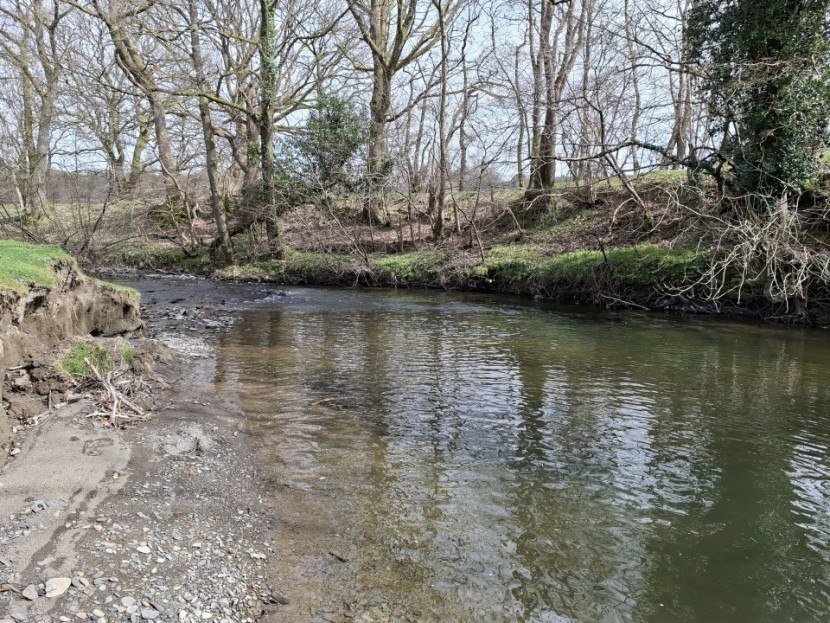 Clwyedog - Joe Alexander from Rhayader
Clwyedog - Joe Alexander from Rhayader On the same day RG from Freshford with a friend had a better time on the Usk Town water, taking 8 trout to 16 inches, mostly on spiders. Andrew Majerus with a companion from Ringwood caught 10 trout on small Olive Emergers at Abercynrig, while two London anglers also caught 10 from the upper Wye at Ty Newydd. Mathew Evans from Caerphilly with three friends shared 16 rainbow trout from Llwyn On.
Matt Williams was fishing the same water with his 12 year old daughter, her first day of fishing, and she caught a brace of rainbows on the spinner. Her father caught three more, plus a small salmonid he thought might have been some kind of hybrid or a very young rainbow. You don’t often get to see the latter in this country unless one slips through in a delivery of adult triploids or you perhaps fish the Derbyshire Wye. I do remember catching baby rainbows on the Belihul Oya on Horton Plains high above the forests of Sri Lanka. This is a magical kind of landscape. We were staying at the Far Inn, but not far from a place called World’s End where you can look down on the clouds and jungles below. These rainbows were strange little things, coloured deep purple and very aggressive to the fly. Occasionally there was a 2 pounder, which is what we were really after.
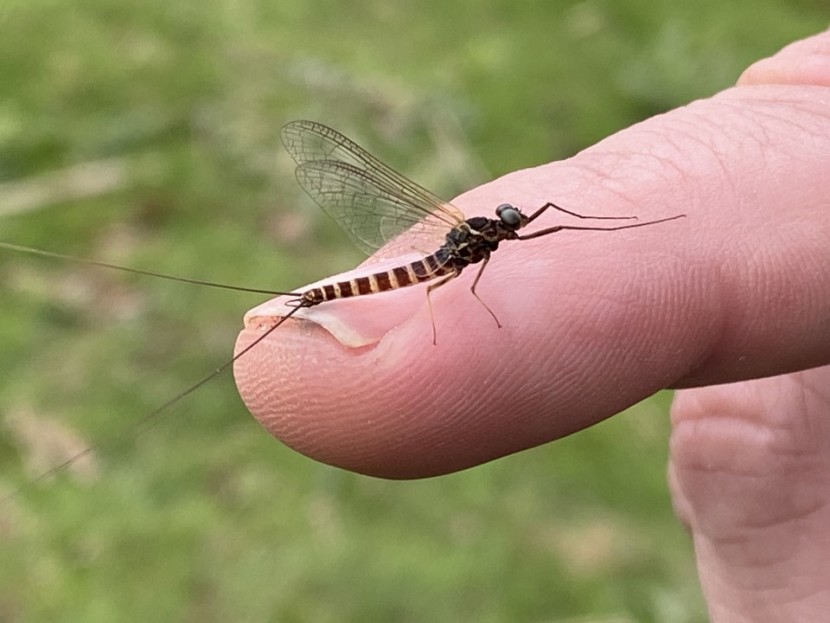 Spinner - Philip Bullock
Spinner - Philip Bullock 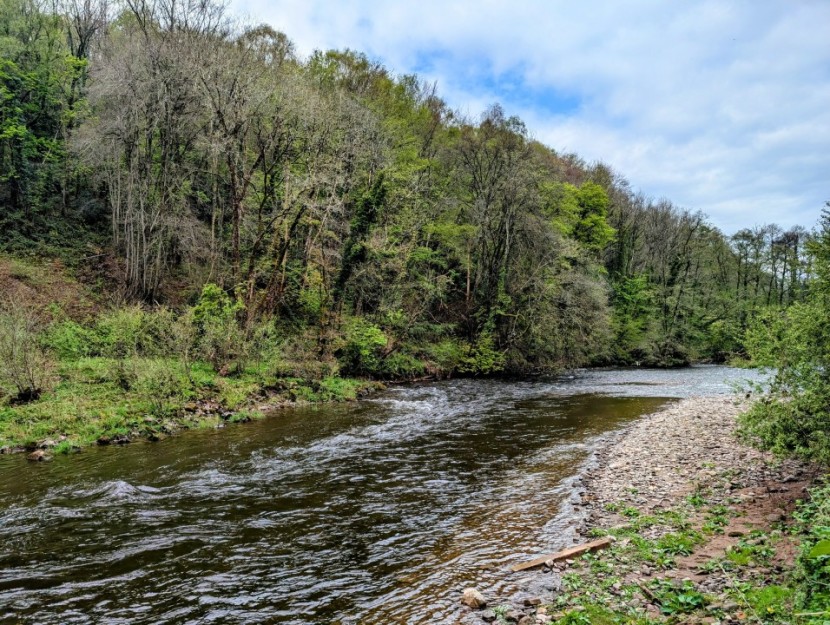 Dan y Parc - SM from London
Dan y Parc - SM from London The only salmon taken in this period came on the 17th, a fish of 20 pounds taken by Adam Price Hunt from Bigsweir at the bottom of the Wye. Needless to relate that the Easter weekend brought some drizzling rain, although only enough to raise river levels by a couple of inches. However cloudy weather helped the fishing now and Philip Bullock with a friend from Churchdown had a good time on the Usk at Dan y Parc: “A soft day…blizzard hatch of sedges 1300 to 1400 with an occasional trickle thereafter.” They caught 11 trout, two of them at 20 inches and two at 16 inches.
Harry Chance from Exeter had 15 trout from the Breconshire Fishery. Rhian Bray from Redditch caught 10 from the Ashford House beat while SM from London had another 10 from Glan yr Afon, in this case by nymphing. William Dickson from North Nibley caught 8 trout from the Beacons Reservoir using a team of three traditional wet flies on an intermediate line. Further north, CE from Aberystwyth caught 10 trout from the Rhosrhydd water having found a place out of the wind. Joshua Moray from Aberdare returned to fish Abercynrig and caught 10 trout on dry flies. Peter Thomas from Kidderminster was on the same beat and recorded 15 trout on nymphs and dries. Chris Southey from Somerset had this to say about the Abergavenny Town Water: “Random feeding. Not holding station. Could have been chasing small caddis but they definitely took every upright. Weird.” It’s difficult to be sure, but grannom pupae rising in numbers might have accounted for this.
Erico Costopoullos from Athens with a friend were not happy with their fishing on the Abergavenny Town Water on the 19th and would not recommend it due to too many dogs and stone throwers. To be fair, this was a town water on Easter Saturday. Personally I enjoy the town waters, all of which have some quiet corners, but I tend reserve them for mid-week rather than high days and holidays. Seth Johnson-Marshall had another very good day on his private Usk beat, taking 9 trout to 2.25 pounds on an olive emerger pattern. Over on the Wye, Steven Russell from Treharris caught 5 trout on a spider / nymph combination at Abernant and Mark Harris from Swansea reported 11 trout on emergers and spiders from the Rectory.
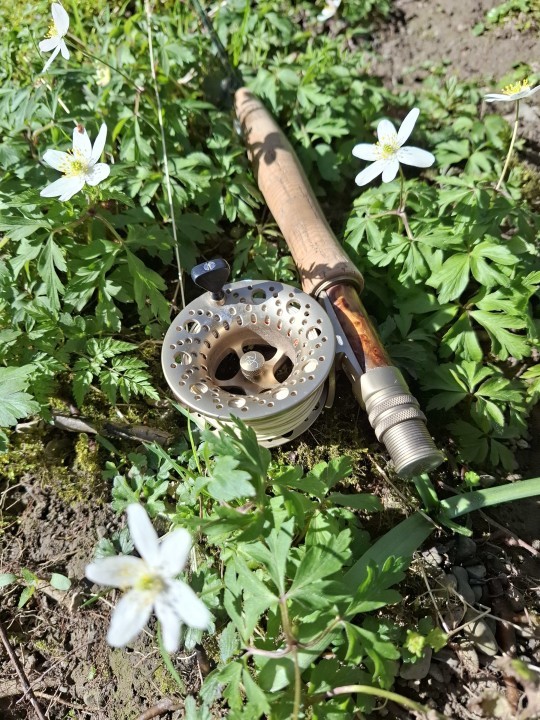 Edw spring - Joe Alexander
Edw spring - Joe Alexander 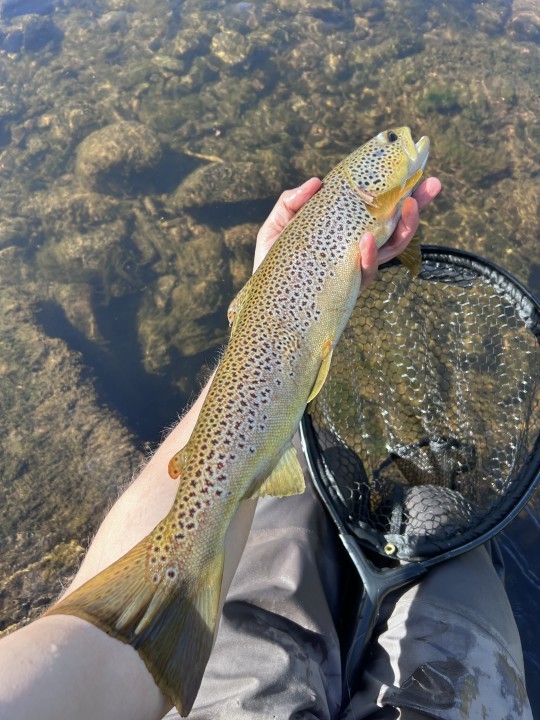 Ashford House - JP from Kidderminster
Ashford House - JP from Kidderminster I have been seeing quite a mixture of flies this month including olive uprights and yellow mays along with the remaining grannom, although not always with fish rising to them. I also noticed the big sea lampreys are in early this year as are the shad. The light showers resulted in a lift of just a few inches on the Wye and cleaned the river bed a little. The Usk actually flooded very briefly and was the better for flushing out the dirt. There were some good days with clients fishing the dry fly on both rivers.
At last on the 23rd came news of more April salmon, with Wyesham reporting a fish of 17 pounds on a Flying C and another of 13 pounds on the fly. Both these fish were sea-liced. RG from Freshford took 5 trout on spiders from the Usk Town Water on the 22nd and 10 more up at Penpont the following day. LM from Builth Wells had 7 Wye trout from the Rectory beat. Up in the Beacons National Park, AS from Blackwood with his son took 6 trout at Llwyn On. Kevin Gould-Davies from Langadog and Tony Lewis from Ammanford had 6 each from the Usk Reservoir. Darren Manley from Pontyclun criticised the access to the MTAA water of the Taff as shown on the access map. I am a member of the MTAA and I have to concede that it could be easier for visiting anglers who don’t know the Merthyr district. Meanwhile Brian Miller from Colwyn Bay who visited the Dolgarrog Fishing Club’s Llyn Coedty had this to say: “The water was devoid of any fish, there were no rises or movement on the lake during the whole morning. Water level was about half. Totally disgusted that the permits were sold for fishing and not just dangling a hook in the water. Am unlikely to be fishing there again.” To which the Fishing Passport replied: “We are sorry to hear of your disgust. The water will understandably be low due to the unseasonable dry spell of weather. Purchasing a ticket to fish does not guarantee catching fish.” I can’t think of much to add to that except perhaps that I wish I had a pound for every morning I have found myself fishing where dour fish were not rising. Such is the nature of fishing.
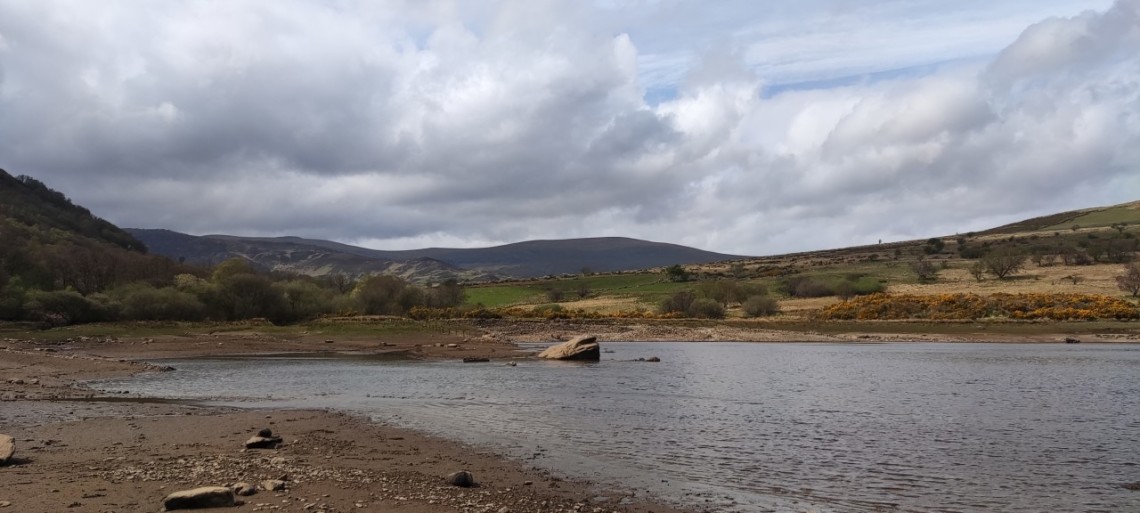 Llyn Coedty - DR from Conwy
Llyn Coedty - DR from Conwy A little more rain and a couple of cloudy days cheered the fishing up further, even while rivers remained low. Andy Lane from London had a good day on the Upper Wye at Craig Llyn on the 25th, despite slippery wading. He caught 10 trout to 1.5 pounds. RD from Blackwood enjoyed catching 9 trout from the Beacons Reservoir: “Great few hours fishing, all caught on black wet flies…” Fred Brown from Dorchester caught 8 trout from the Usk at Greenbank and the following day had 9 more at Dinas: “Trout on March browns, brilliant…” Rob Cooksley from Bristol had 7 trout at Cwmwysg Ganol while JP from Kidderminster caught 10 at Ashford House on an olive emerger pattern. The sun was hot and the water skinny, but fish were rising.
GM from Shrewsbury caught 14 trout from remote Llyn Bugeilyn. He had walked all the way in from the road, but reckoned the access track to the lake is now good for a car. Mike Bowlker from Kidderminster caught 9 trout from fast water at Llandewi on the Ithon. We had a very strongly worded report from Peter King of Barry with a friend who fished Llwyn On unsuccessfully and found poachers’ long lines laid in the water. They did report this to Welsh Water for which I am grateful. Other were successful on the same day and Christopher Evans from Merthyr with a friend reported catching 11. Jaroslaw Lipinski was back for another 4. Mark Payne from Blackwood took 4 but complained about discarded nylon and rubbish on the bank. Caleb Walton from Winslow was unhappy with the state of the access to the Usk at Glan y Cafn: “400 yards fishable at the most…absolute waste of money for fly-fishing…however saw 3 kingfishers, one heron and several sand martins.” There are some heavy trout in this part of the river and Mr Walton lost several fish, however I do concede that much could be done to improve the access at Glan y Cafn judging from when I last saw it.
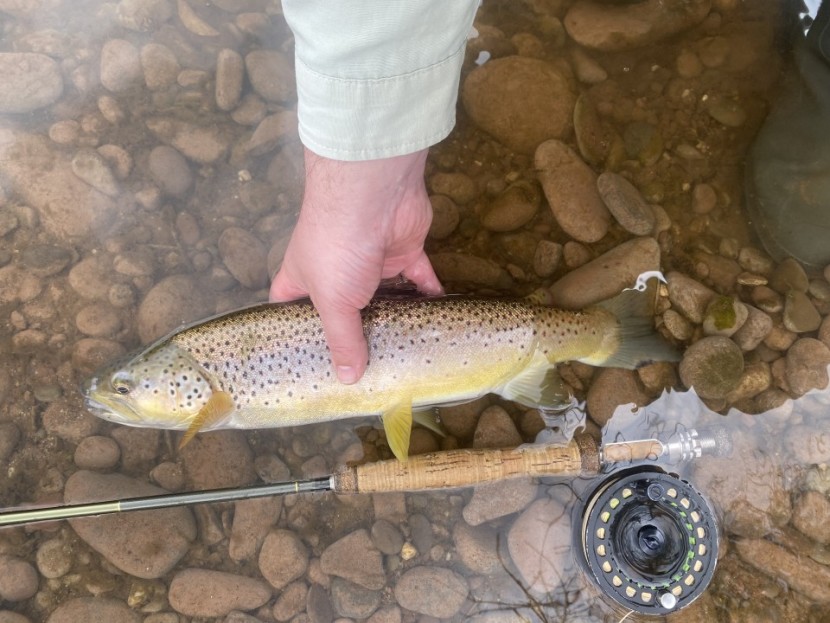 Dan y Parc trout - Philip Bullock
Dan y Parc trout - Philip Bullock 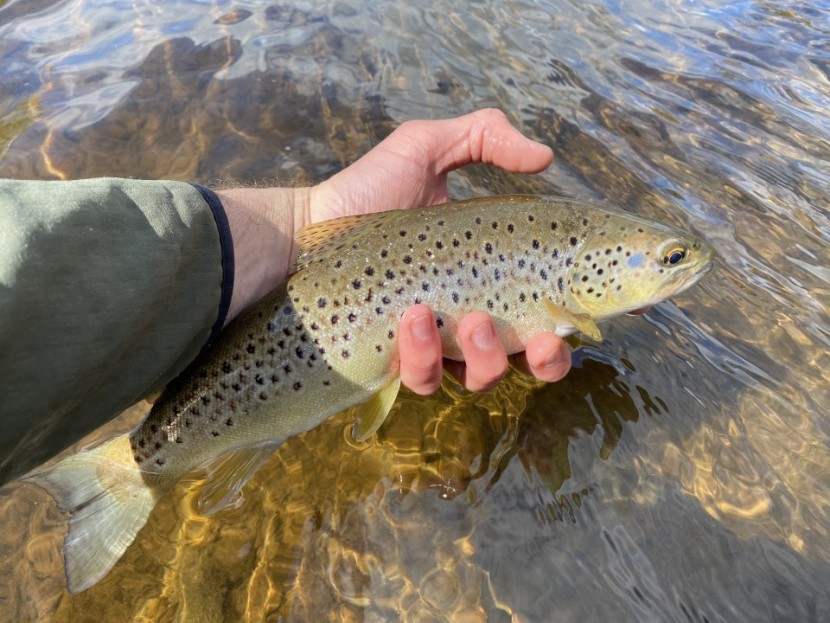 Upper Tower - FR from Hereford
Upper Tower - FR from Hereford Andrew Kelton from Churt reported 4 fish to 16 inches from Greenbank, although rises had stopped by one o’clock. BP from Pembridge got 8 trout on nymphs from the shrunken Lugg up at Litton. Joe Alexander of Rhayader fished the Arrow at Kington for 9 trout on the dry fly, noted that medium olives and large brook duns were in evidence, and wanted to know if there are any plans to remove the weir on this beat. If it were up to me, I would remove most of our redundant weirs in the interests of fish movement, but it is surprisingly difficult to obtain the needed permissions. And these days the fashion is for wild reintroductions, so with beavers arriving I expect we will see more dams and weirs.
No more salmon were reported during this period although some grilse were apparently seen at Usk. The water just wasn’t there. Joe Alexander was out again on the small streams, this time on the Edw at Cregrina, and he had 11 trout on dry flies during a spell which was really becoming quite hot, reaching 25 degrees on some afternoons. Andrew Wilson from Ledbury with a friend fished at Llangoed and Lower Llanstephan and mentioned getting their vehicles “…a free car wash courtesy of Friesian herd.” In all seriousness I would not leave cars parked unattended in a field holding cattle, which can do a lot worse than slobbering, sprinkling and smearing over them – for example rubbing the door mirrors off in the process of scratching themselves and then giving the panels a good kicking. I supposed it’s merely curiosity on behalf of the cattle, but I would rather deny them the opportunity. Seth Johnson-Marshall who is part-owner of the Rectory beat described a late evening fishing the tail of the Rock Pool which under present circumstances is quite accessible. During a “frantic last hour” with plenty of rising trout he caught 9 on CDC olive emergers. He mentioned large numbers of yellow may flies which I also associate with the same pool.
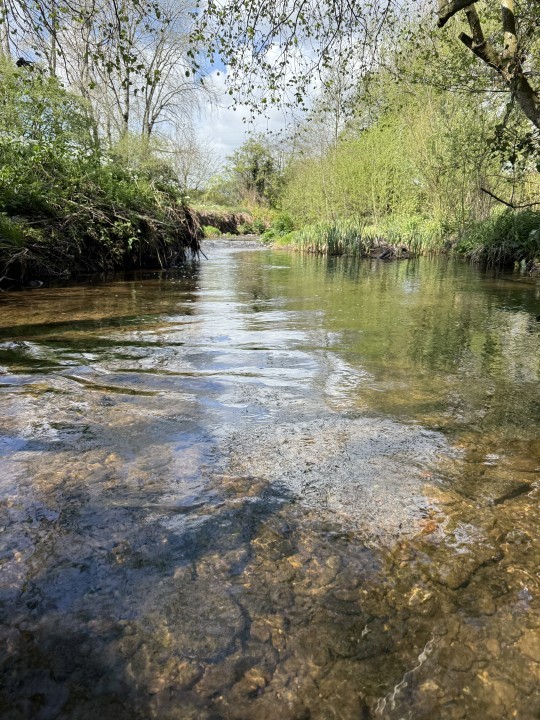 Bideford Brook - SH from Cheltenham
Bideford Brook - SH from Cheltenham 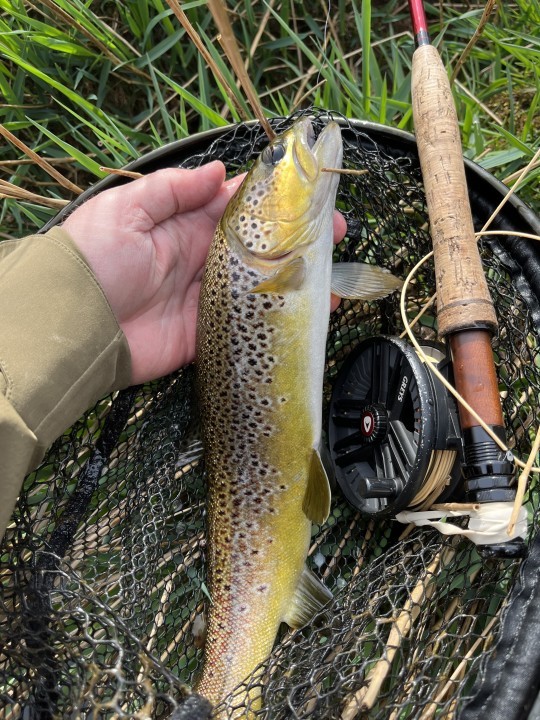 Dinas trout - Dan Cristian Oprea
Dinas trout - Dan Cristian Oprea Most Usk anglers will have read of a recent decision concerning the Monmouthshire and Brecon Canal. The 35 mile long restored canal operates by taking off Usk water from a dam and weir just above Brecon town and eventually returns it to the lower part of the river, less of course the losses from leakage and evaporation. To date the Canal and Rivers Trust which currently manages the canal has been able to take as much Usk water from Brecon as it needs without charge. However, leisure use of the canal and its locks has been increasing and there are plans afoot to restore some new sections in the lower part of the valley, while at the same time there have been serious concerns about low levels of flow in the river during recent summers of drought. It should also be remembered that the Usk is used as a conduit between reservoirs to supply water to Newport, and this also has an effect on natural flow. By the new decision the Canal and Rivers Trust will be obliged to seek licences from Natural Resources Wales to take extra amounts of canal water, for which they will have to pay. Put simply, this might be good for the river but bad for the canal. Interestingly, the Merthyr Tydfil Angling Alliance, which has fishing on a length of the canal below Brecon, but quite a lot more good trout and salmon fishing on the middle river around Abergavenny, is recommending its members to petition against the new arrangement. The whole matter came to a head in April with anti-cyclonic weather, no rain and wild fires on the hills. There just wasn’t enough water draining off the Beacons to supply all the interests hoping for flow from the Usk during such a dry spring.
According to the latest information I have, would-be organisers of a three day and night drum and base music festival for thousands of guests have now withdrawn their planning application to Herefordshire council to hold the event at Oldcastle in a remote part of the Monnow valley with camping beside the river. One very valid objection amongst many was that the roads here are single carriage-way with passing places, causing obvious difficulties for emergency vehicles. However, it seems that the Pullup Recordings or Gemfest website is still selling tickets at 80 pounds a head for a festival somewhere, and the latest news I have is that this is to take place from 13th to 15th June at Malmesbury in Wiltshire.
I could hardly resist buying a copy of Nicholas Fitton’s book, Gently Down the Stream which came out recently. Subtitled The Forgotten Art of Downstream Wet-Fly Fishing, this book deals head-on with a method which I actually think is not forgotten at all. More accurately, a lot of anglers, including good ones, do fish that way at times or even often, but are a bit embarrassed to own up to doing so. There is such a history of arguments about wet fly methods that this book is therefore something of a polemic, in that there is an expectation of attack and the tone of what is written is therefore decidedly defensive. Rather sadly, Nicholas Fitton, who had been a well-liked teacher and apparently something of a jazz musician as well as an angling author, died shortly after his book was published so that this will be his last word on the subject.
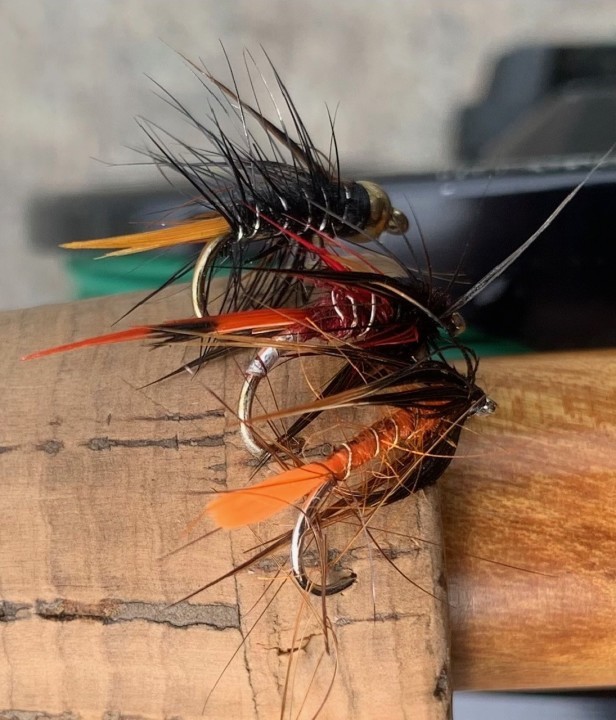 Team of wet flies - William Dickson
Team of wet flies - William Dickson The “right” way to fish a team of wet flies has been argued about for a couple of centuries and involves quarrels almost as bitter at times as the early 20th century disagreements between GEM Skues and disciples of Halford about whether it was acceptable or even honourable to fish in or below the surface of chalk streams rather than on top. The nymph and dry fly argument rumbles on even today to an extent. The early protagonists of the “wet fly up and down” arguments were the 19th century anglers WC Stewart, who wrote The Practical Angler in 1857, and Henry Cholmondely Pennell, who, apart from inventing hooks and flies, wrote a number of fishing books including The Modern Practical Angler in 1870. That last title caused a lot of trouble. Stewart was a Scot who fished northern rivers and insisted that the best and indeed only proper way was to fish wet flies up with a long rod and short line, constantly dapping his flies on the surface and lifting them off to re-present them. Pennell was a southerner who lived in Weybridge, roamed widely when fishing for different species, and cast a longer line down and across when fly-fishing rivers. Stewart was a fiery Scot, still young, famous for his fishing and insistent on his method; Pennell was equally insistent on his own preferred method, perhaps had a rather unwise sense of self-importance, could give as good as he got, and indeed continued to do so even after Stewart’s untimely early death. At its height the quarrel was about as personal as it could get, and as was usual in those days took the form of strongly worded letters to The Field, these being rather like salvoes fired in turn from opposing dreadnoughts. Thank God the internet and social media were not invented then; eventually the editor of The Field wisely called a halt to the exchanges, possibly concerned that there might be a return to the notorious duelling of the previous century.
The disagreements on the subject of wet fly fishing went on long after the deaths of these two protagonists and indeed continued through the 20th century even to this day. Arthur Ransome described: “A Caution to Anglers, a pamphlet of embittered argument between the two of them in which there are accusations of plagiary, of lying and even of bad fishing. Well, they have both been long dead and, I suppose, fish the Styx, one fishing up and one fishing down and pass each other without speaking. Stewart’s is the better book and the better advice but Pennell’s is also worth reading.”
Well, the famous writer, spy and Lakeland fisher Arthur Ransome felt he had to pick a side in the end, but others have been much more ambiguous on the upstream versus downstream debate. This was not merely a matter of northern method versus southern method based on different kinds of rivers. Another famous 19th century Scottish angler, William Stoddart, reckoned to fish down. So did the entomologist Alfred Ronalds. In his book Nicholas Fitton quoted yet another Scot, EM Tod: “I shall fish it up or down, according as I find it fishes best and easiest.” I am told Reg Rhygini used to fish downstream.
Coming nearly up to date, I have watched the late Oliver Edwards, in his day considered by many of us to be the best wet fly fisherman in the North or indeed anywhere, giving an impassioned endorsement of Stewart’s upstream method. He particularly emphasized the advantage of approaching fish from behind and thus avoiding spooking them. On the other hand Edwards also made a beautiful video on spider fishing North Country-style including a method of fishing a team of flies down and across which he described as the Escalator. I have a sympathy with this method, which involves casting across with a long rod, throwing in one or more upstream mends to control the movement across the river and tracking them down with the rod held high while watching for takes. (Incidentally I still find it intriguing that Oliver Edwards, who had such a reverence for Stewart, also departed from his hero on the subject of fly patterns. Stewart confined his fishing to just a few - and in fact he listed only 9 - simple and impressionistic spider style wet flies, being all that he considered necessary. Oliver appreciated the value of simple and impressionistic spider patterns, but he himself designed the most complicated and beautiful exact imitations which could be conceived. I am very proud to own a small box of imitative flies tied by Oliver Edwards).
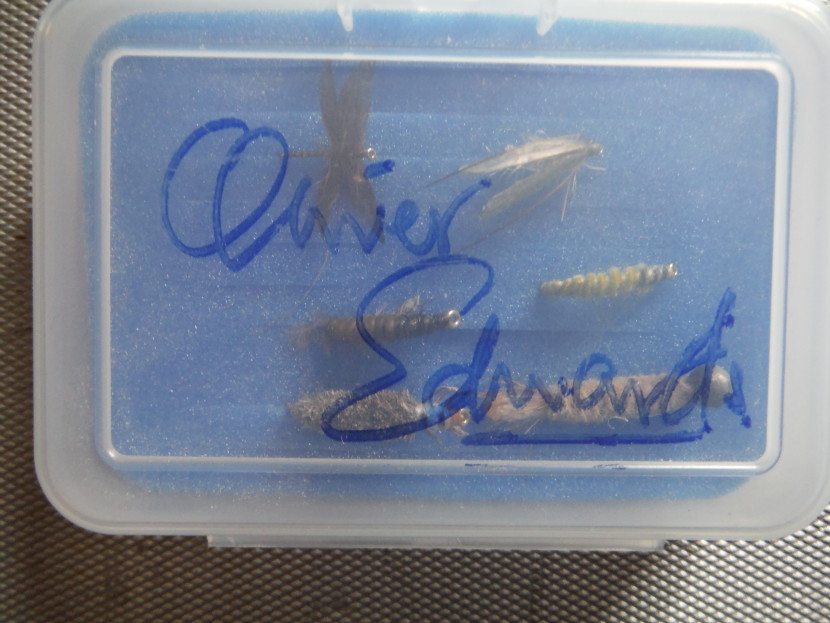 Oliver Edwards flies
Oliver Edwards flies 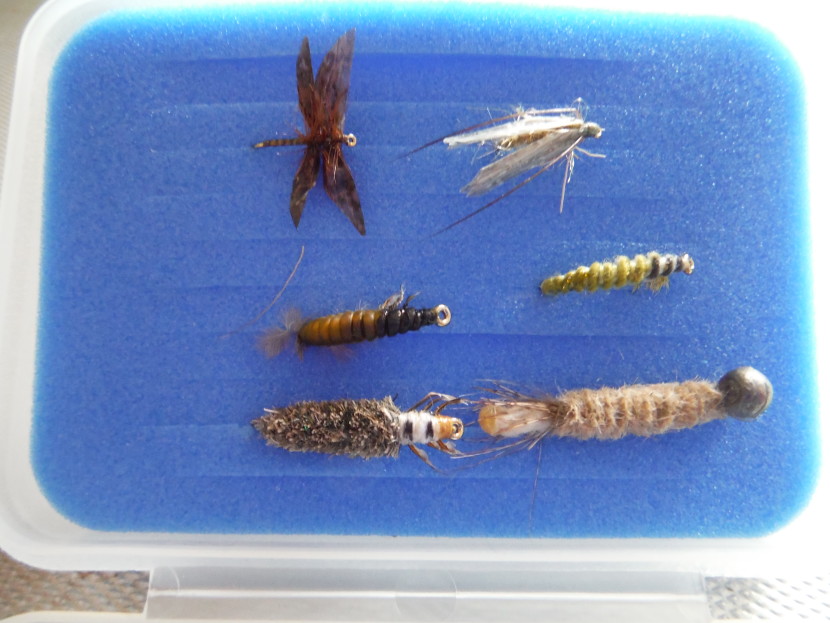 Oliver Edwards patterns
Oliver Edwards patterns Given the history of disagreement on this subject, one might assume that the existence of Terry Lawton’s book The Upstream Wet Fly, published by Robert Hale in 2011, in some way provoked Nicholas Fitton to reply with Gently Down the Stream as a way of balancing the argument. After reading both, I am guessing that was not the case. Fitton does not mention the Lawton book in his bibliography, and they are two very different works, approaching the subject from quite different angles. Terry Lawton’s book mainly consists of an extensive research of the whole history of wet fly and other fly-fishing methods, with some very interesting quotations, going as far up to date as Jim Leisenring and the American school of wet fly fishing. As such it is a very good read, but it is short of modern practical advice.
Nicholas Fitton by contrast gives his readers a lot of fishing examples from his own experience, and does explain in detail how he fished downstream and why he often did so. His book, complete with diagrams, gives a lot of technical information about problems on the river which you can solve with a team of wet flies fished from above. He was obviously not a purist in any sense and describes various occasions when he chose for good reasons to fish up, although then again he slips into a slightly defensive mode when writing about fishing down. He may have had a reason for that. These days, devotees of other methods, whether it might be heavy nymphs, “klink and dink,” or indeed dry flies, tend to talk slightly disparagingly about what they call “swinging wet flies.” Those who do no more than that do not appreciate the full possibility of the method. Fitton makes it very clear that if the angler just acted as a static pivot while the current dragged the flies round below him in an arc, the result would not be very good. Fitton instead emphasizes the importance of guiding the team of flies through the water using the movement of the rod. This method is more tactile than visual and the rod is used, as he puts it, like a conductor’s baton in directing the flies from one side to the other while feeling for the take.
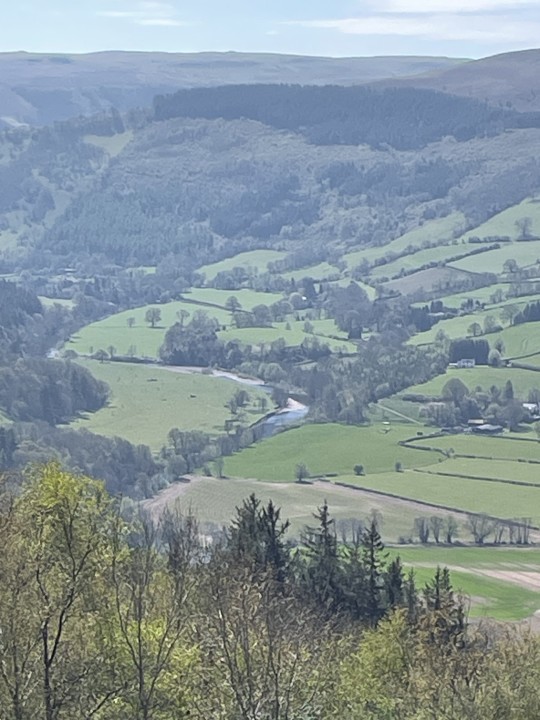 Usk Valley at Buckland - SI from Newbury
Usk Valley at Buckland - SI from Newbury 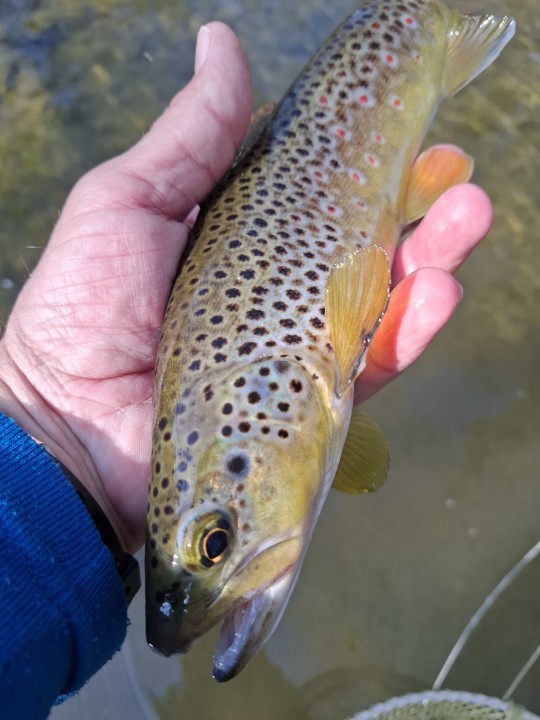 Edw Hergest trout - Joe Alexander
Edw Hergest trout - Joe Alexander Certainly his book had me thinking about certain differences between his methods and what I do. I gather he was often prepared to use the same sort of rod length, 9 feet, as I would use on open rivers for the dry fly. I like a 10 foot soft actioned rod for my team of spiders, appreciating the reach and control which the extra foot gives me, especially when mending line, which I do a lot. Fitton used thicker nylon than I would choose. I normally use 3.2 pounds breaking strain Bayer Perlon which may seem fine but on a number of interesting occasions I have landed an accidental salmon up to 18 pounds with it. BP is good stuff provided the rest of the tackle is suitably balanced, and bear in mind my hook sizes are normally 14 and 16. Oliver Edwards used to tie his leaders with 2.6 pounds Bayer Perlon, the next size down. Fitton used a shorter leader with no tapered section and liked his flies quite close together, 20 inches or at most 24 inches; I normally fish my three flies a yard apart on a leader with a tapered butt and a total length of as much as 14 feet. This difference may be because I gather Nicholas Fitton sometimes used multiple wet flies on brooks, while I generally reserve this method for the open pools and runs of the main Wye and Usk. On the other hand Fitton describes sometimes throwing and fishing quite a long line, while I am much more confident restricting myself to a maximum of 30 feet outside the rod tip. In fact all my river fishing lines have a black band made with permanent marker at 30 feet, thinking it will remind me to avoid “long range sniping” and adopt the obvious option of wading closer when possible. Fish fine and far off by all means, but not too far. I find I hook more taking fish if there is not too much of the line lying on the surface. I also try to pay attention to the speed of the flies as they track down and this involves care in mending line and pointing the rod to control the direction. Fitton speaks a lot about these aspects. In this sense I think the method is rather like wet fly salmon fishing, but on a lighter scale. The big difference is that Fitton seemed to “work” his flies a lot as an attractor, drawing them round in a curve with short pulls, particularly in the later stages of the swing. I sometimes work the flies, but much more usually I do not, trying to keep the dead drift going as long as I can and letting no more than conflicting strands of current work the flies a little against each other as they come round. However, when the flies have come round below me, I do draw in a yard or so of line as I take a downstream step and then shoot that line back into the new cast across. I must admit that those couple of pulls upstream sometimes provoke a take.
Mr Fitton’s book is an intriguing and thought-provoking one, such that I am still considering over some of his described tactics. It is certainly a recommended read if you are interested in wet fly fishing on game rivers.
On the final day of April we have just 15 springers recorded, the best fish being 26 pounds. Hopefully we can look forward to the mayfly next, this mainly being a fly of the tributaries where there is sufficient silt to house the growing nymphs, and we can expect to see hatches on afternoons in late May and early June. I prefer a muggy, cloudy day to a bright one and we do need rain.
Tight lines!
Oliver Burch
http://wyevalleyflyfishing.com